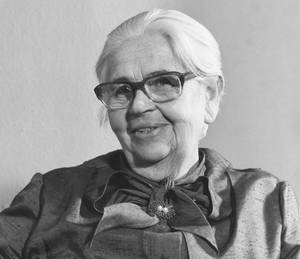


As a child, she experimented in her grandfather's laboratory, and as a chemist, Edith Weyde made a Career for the Actien-Gesellschaft für Anilin-Fabrication, or Agfa for short. She developed stabilizers for photographic paper and invented the first photocopying technique.
Edith Weyde was born in Prague on September 17, 1901 and grew up in Ústí on the Elbe in northern Bohemia. Her father came from Austria and was a high school teacher. Her grandfather, who studied botany, zoology and chemistry, owned a laboratory that sparked his granddaughter's interest in scientific experimentation at an early age.
With the Abitur in 1919, Weyde acquired the general higher education entrance qualification, but she did not immediately start studying chemistry ? probably for financial reasons ? but initially worked for four years as a laboratory assistant in the Austrian Association for Chemical and Metallurgical Production, an industrial company in Ústí.
It was not until 1923 that Weyde began studying chemistry at the Technical University of Dresden. After only four years, she completed her dissertation on "New materials for X-ray screens" and received her doctorate in engineering. Her PhD supervisor was the chemist Robert Luther (1867-1945), founder and director of the Photographic Institute at the TU Dresden and professor of physical chemistry there. Before Luther was appointed to the chair in Dresden, he had been doing research for a long time as an assistant to Wilhelm Ostwald (1853-1932), winner of the Nobel Prize in Chemistry, in Leipzig.
In 1928, on the recommendation of her doctoral supervisor, Weyde accepted a position in the photographic-photochemical laboratory of IG Farben in Oppau near Ludwigshafen. In 1932 she moved to the Actien-Gesellschaft für Anilin-Fabrication, Agfa for short, in Leverkusen. It was here that her professional and academic Career took off.
One of Weyde's first tasks at Agfa was to optimize photo paper so that it can be processed and stored better in warm, humid environments. She developed stabilizers for the photographic layers, thanks to which the papers were suitable for use in the tropics. Weyde was also involved in the development of the first Agfacolor papers for color photography. Her area of responsibility also included material testing and the evaluation of customer complaints. Careful examination of the complaints and intensive research into the causes finally led to her most important discovery, the previously unknown diffusion of silver salt in the photographic layers. This unwanted process affected the quality of the photos and was a reason for numerous customer complaints.
In the classic development process, a negative was first made, from which the positive, the actual photo, was created in the next step. For this purpose, the photo prints were taken in a stack from the developer bath to the fixer bath. Weyde recognized that unexposed image silver was separating from the developer-moist prints, diffusing into the back of the layer adhering above and being fixed there. This resulted in blurry negatives and unsightly smudges on the otherwise light-colored back of the photo.
With the discovery of silver salt diffusion, Weyde came up with the idea of a new technique that developed negative and positive at the same time, thus saving enormous amounts of time when making copies. The technology was ideal for the rapid duplication of important documents, for example in everyday office life, for which the time-consuming photographic process was not suitable. Weyde developed the idea to market maturity.
On January 25, 1942, Agfa received the patent for Weyde's "Process for the Accelerated Production of a Photographic Positive Image from a Master". Because of the Second World War, the technology known as Copyrapid only came onto the market in 1949. Immediately after the currency reform in 1948, Agfa invited all well-known German manufacturers of photographic products to construct an office photocopier based on Weyde's invention. Walter Eisbein, co-owner of the Stuttgart company Trikop, needed just eight weeks for this. His device, called Develop, exceeded all expectations. After the presentation of the new photocopying process, the name "flash copy" used by the manufacturers and inventors became established.
The flash copy was immediately successful and also conquered other European countries. In the USA, the copying method came onto the market in 1952. As with many innovations, parallel developments took place. At the end of the 1970s, the diffusion copying process was superseded by new technologies such as the Xerox process. Ultimately, however, we owe it to the chemist Weyde and her inventive talent that the copying of papers and other documents is so common today.
Edith Weyde died on February 10, 1989 in Kürten, a municipality in North Rhine-Westphalia. Although her brilliant achievements are largely unknown to the general public, Weyde has received several awards in professional circles. One of the most important honors was the culture prize of the German Society for Photography, which she was awarded in 1963.
a notice
The texts published in this series do not claim to be scientific publications. Authors and other people involved are not experts in the history of science. The purpose of the series is to introduce the mostly unknown women chemists and to remind you of the well-known women chemists. We encourage readers who want to know more to study academic Literature on the women featured. In some cases there are detailed chemical-historical works.
authors
Prof. Dr. Eberhard Ehlers
Prof. Dr. Heribert Offermanns
Editorial processing
Dr Uta Neubauer
project management
Dr Karin J. Schmitz (GDCh public relations)
The authors are responsible for the content of the biographies.
The content presented on these pages has been carefully compiled. However, the authors, Editorial staff and publishers assume no responsibility or liability for the completeness and correctness of the content or for typographical errors.
Photo: Portrait of Edith Weyde author Harald Koechlin BY, Attribution: http://commons.wikimedia.org/w/index.php?curid=49097112
back to overview biographies of female chemists
back to publications
This page has been machine translated. If you have any feedback or comments please feel free to contact us. 
last modified: 21.04.2022 09:34 H from K.J.Schmitz